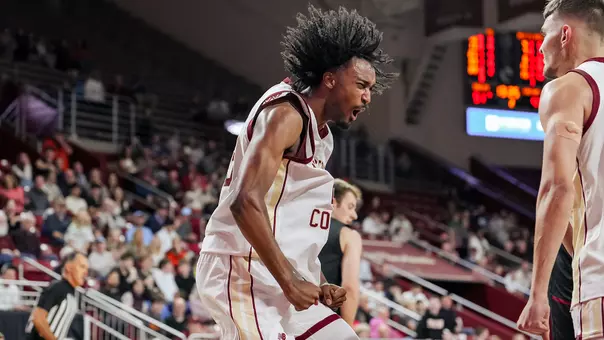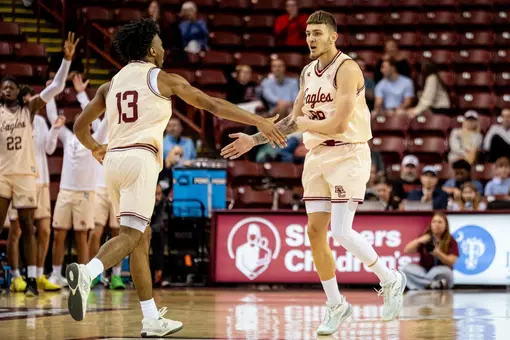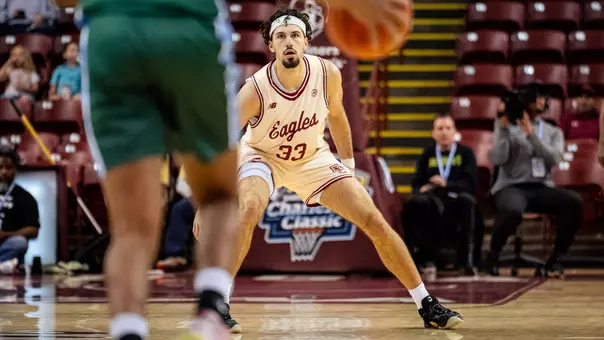
Photo by: Eddie Shabomardenly
Friday Fast Break: Week X
February 11, 2022 | Men's Basketball, #ForBoston Files
The building rocked, but BC fell just short against Syracuse
CHESTNUT HILL, Mass. -- The sports fan in me gravitates towards any romanticization of the game. I analyze plays and numbers through a more objective perspective, but appreciating matchups for the intangible attributes is why the little kid in me is still seared into my brain and my soul. Every game serves reminders of familiar feelings dating back to when I believed players were gods and coaches were these titans with larger-than-life personalities. The chants and cheers are all part of the experience, and I attempt to recapture adrenaline rushes even if there isn't any cheering allowed in the press box.
Tuesday night was one of the rare occasions where running late actually helped me regain those familiar feelings. I cut a deal with my wife that involved putting the baby to bed before leaving for Conte Forum, so I didn't pull into the parking garage until it was getting close to the opening tip. I didn't exactly carom into my parking spot on two wheels, but I absolutely did that brisk sprint-walk as I moved past Alumni Stadium.
Normally I'd get to the arena early enough to soak in the quiet serenity of an empty building, but showing up later than usual meant I filed into the building with fans of both Syracuse and Boston College. I walked through a doorway to see a mostly-full building already situated for the starting lineups, and the bright lights seemed to illuminate the buzz and murmur of a crowd ready to battle on both sides. It jacked up my adrenaline levels, and they never really tempered down as the fan bases rooted for their teams from the opening tip.
The fact that Syracuse was the opponent clearly didn't hurt the situation. I grew up watching the battles of the old Big East, and having the Orange in the ACC all but guaranteed an old school atmosphere on par with those old gymnasiums. Having both fan bases in the house offered more special feels, like the game was somehow playing out in a dingy gym like in Hoosiers, and because the rivaling chants and cheers bounced back and forth off one another throughout the game.
Boston College lost to Syracuse, and the analyst in my brain inevitably traversed the road back to breakdowns and analytics. I rewatched the game as usual and took notes opposite what head coach Earl Grant said in his postgame press conference, and I took a vastly different perspective from the emotional, fan-based point of view. It pushed the conversation around turnovers, missed opportunities, extra passes and zone defenses and set a tone for the X's and O's of the game.
But sitting courtside and listening to the fans proved to me that college basketball is alive and well in Boston. Fan bases show up at each other's court when the game is important, and they chant at one another when the opponent matters. The rivalries embed themselves deeper, and the dueling remains days later.
That's what college basketball is all about. That's what happened on Tuesday. The fan in me loved it and can't wait for more.
Here's a recap of what we learned from the Syracuse game with a little help from "White Men Can't Jump," an all-time favorite movie I still rank as one of the best overall sports movies:
1) "I'm in the zone!" - Billy Hoyle
The 2-3 zone is one of those fundamental defenses taught at every level of basketball, but the widespread utilization clouds the understanding of its difficulty in implementation. While basic, its truest form requires intense communication to get five players to operate as one cohesive unit moving back and forth across a defensive area. At its best, it takes away the post and high percentage shots while forcing teams to shoot from outside, which is why it exists as a winning formula at levels where players are unlikely to hit the 3-ball.
Syracuse's 2-3 zone is altogether different because it combats outside shooting in an era built around 3-point sharpshooters. It augments the interior presence by moving bigger defenders into a more exterior position, creating almost a triangle of defenders operating from the top of the key and the elbows down to the inside paint. The wing defenders then close off the baseline, but the string approach allows the bigger defenders to rotate lower in order to supplement the center.
When executed correctly, it completely slams the door on an opposing offense, and on Tuesday night, the Eagles found themselves directly in the center of that maelstrom when they missed their first dozen shots. They were left with a single point on a free throw until Quinten Post laid a third chance opportunity into the hoop at the six minute mark, and they didn't hit their first non-second chance shot until Brevin Galloway worked inside with under 12 minutes remaining.
They eventually course-corrected when foul trouble against Jesse Edwards opened up opportunities underneath for Post, who went 7-for-13 in 26 minutes as part of a 14-point, 14-rebound double-double. He forced Syracuse to double-down and collapse its defense into the paint, which in turn opened up outside shots and drives for Jaeden Zackery, who finished with a game-high 18 points while simultaneously recording six rebounds and six assists. As he kicked it in and out, the 3-pointer, which was absent in the first half, started to fall and prevented Syracuse from ever truly pulling away for good.
"We wanted to probe the zone and distort it," Grant said. "You want to try to get the ball into the paint first before you attempt a lot of shots from the perimeter, so you can get inside-out, no-doubt threes when the ball is coming towards you and you have rhythm. We wanted to try to post some and get some partner-passing, and we had some opportunities but didn't capitalize. We did a much better in the second half, so it was pretty simple. We won the second half but had too many turnovers and didn't make shots at the rim [in the first half]. If we were a little bit better in the first half, [the result] could have been different."
2) "Sometimes when you win, you really lose, and sometimes when you lose, you really win, and sometimes when you win or lose, you really tie, and sometimes when you tie, you really win or lose." - Gloria
Back to Edwards for a minute. I long bought into Red Auerbach's famous quote that "you can't teach size," but the old-fashioned, 7-foot center feels more and more like a lost art form with basketball's shift to outside shooting. They increasingly need to shift out of the post in order to hit an outside jump shot, a fadeaway or even a launched three-point attempt, and they serve more as facilitators than finishers whenever a team goes through its inside-out motions on offense.
Jesse Edwards, though, is a completely different cat, and he patrols the paint with an old-fashioned toughness developed by Syracuse's commitment to the zone defense. His old school presence is a story told through his ability to block shots, and his intelligence made him more likely to gain rebounds while furthering those high percentage shots. He hadn't attempted a single three-pointer in any of his 53 games prior to Tuesday, and his breakout this season included a combined 17-for-20 against NC State and Louisville in the two games before his trip to Conte Forum.
Yet Edwards had one hole in his game - he is prone to foul trouble. He fouled out of five consecutive games across the end of December and beginning of January before stretching the streak to six-of-seven games against Clemson. The majority of the numbers came well after he scored double figures and included one double-double, but I figured BC, with Post and James Karnik, had an opportunity to tilt Edwards a bit with its own smashmouth offense.
Edwards struggled against BC and played arguably his worst game of the season after he fouled out with only 13 minutes on the floor, and while it was revealed on Thursday that he will miss the rest of the season with an injury, going 0-for-3 from the floor meant he failed to record a point for the first time this season. He had both a block, a steal and an assist, but he couldn't get more than two defensive rebounds because of the combination preventing him from ever getting into a rhythm.
"It wasn't so much about trying to foul him out of the game," Grant said, "but we wanted to make sure we had a post presence. I thought we did have that presence. We wanted to throw the ball inside and make sure we had balance. We didn't want to just take threes so we tried to get it inside as well. Because we did that, we were able to get aggressive around the rim. We saw that he got in foul trouble early, which really helped us, but it was really just an emphasis on getting the ball inside."
Syracuse defeated BC with timely shooting and a better outside presence, but the Eagles' game plan worked despite the early shooting woes. Grant switched from Karnik to Post early in the first half and negated the Orange's size advantage, and the game was never truly out of reach after the Eagles heated up. That by itself is proof of the system working, and as execution improves both through the remaining games and into the offseason, there's a dangerous future looming for the ACC's middle tier.
3) "You can put a cat in the oven, but that don't make it a biscuit." - Sidney Deane
This season has been about taking positives from every game, win or lose, but counting those results still matters for the postseason discussion. BC entered Tuesday night in position to jump into a group of teams fighting for a first round bye but instead exited the game still fighting for an opportunity to create noise when the conference arrives in Brooklyn in March.
The loss to Syracuse dropped BC to 4-8 in league play and sent the Eagles into a tie for 11th place with Clemson. They currently hold the head-to-head tiebreaker in that matchup after beating the Tigers with the upset comeback a couple of weeks ago, but they play again on February 26 when Clemson visits Conte Forum. That game will likely hold some serious postseason implications since a win to split the head-to-head tiebreaker moves them into a secondary tier tiebreaker of better record against league teams starting with the No. 1 seed.
That's currently Notre Dame, which lost to BC by 16 in December, but a return bout on February 16 will further play into the Fighting Irish's role in determining the lower seeding. Duke and Wake Forest are also breathing down their top slot, so there's still plenty to break down as March draws closer.
BC, though, has an opportunity to gain some positioning in the next couple of weeks, and the Eagles still have a very good shot at earning a bye for the first round's opening day games, where the lowest six seeds play. They are a game behind 10th-seeded Louisville but are less than two games behind Florida State and Virginia Tech, the two teams currently seeded eighth and ninth.
The No. 8 and No. 9 teams play each other in the first round, while the remaining three teams seeded fifth through seventh await first round winners and the top four teams gain the infamous "double bye" directly into the quarterfinal round. It's a bit much to try and factor how many games would get BC into that bubble, but the two-to-three game difference between the Eagles and Syracuse offers a glimpse into last Tuesday night.
BC has Duke on Saturday, but after drawing Notre Dame, a team it beat in their first meeting, the seas part for the Eagles to control their own destiny. Games against Syracuse, Florida State, NC State and Clemson start on February 19, and after a home game against Miami on March 2, a road game against Georgia Tech closes the regular season. All of those teams, including Miami, which dropped two in a row before beating Georgia Tech on Wednesday, have a stake in how this plays out.
Layup Line: In Appreciation of Coach K
I readily admit I lamented the loss of old rivalries when Boston College left the Big East. I loved that conference and specifically enjoyed the basketball matchups that dotted the Northeast. I grew up rooting for anything Massachusetts or New England in those days, and I always felt like the battles with Georgetown, Villanova and Providence made for the perfect neighborhood theater.
As I got older, the move to the ACC started making more sense, and I came to realize how necessary it was to leave the Big East behind. College sports were becoming more national, and the new league held the gateway to some pretty iconic moments against some of the biggest programs in their respective sports' history.
That was never clearer than on February 1, 2006. Like this week, the Super Bowl loomed large, but with the New England Patriots absent from the big game for the first time after winning three of the last four big games, a Wednesday night game between Boston College and Duke stood as one of the largest sports stories in the region.
BC was No. 15 in the nation going into that game, but three of its four losses came during the first seven games of its inaugural ACC campaign. The Eagles had been as high as sixth in the nation before a two-point loss to Maryland opened league play, and the consecutive losses to Georgia Tech and NC State made for an interesting start to January before things got back on track against Florida State.
But Duke was still Duke, and no home game amounted to the fever pitch on the floor when the second-ranked Blue Devils, who had been ranked No. 1 for the entire season before a loss to Georgetown derailed the perfect season, swaggered into Boston. They were undefeated in the league and had every element for a special season. J.J. Redick was the Duke player everyone loved to hate, and Greg Paulus was a freshman heir apparent to that ignominious throne. Shelden Williams was a defensive stalwart and assuredly a first round pick, and Coach K - the new United States national team coach trusted with reclaiming international glory for the NBA superstar roster - was behind the bench with his three national championships.
It produced an atmosphere at Conte Forum that's been difficult for any game to match and nearly featured a historic rally by BC, which trailed by 18 in the second half but ultimately lost by two after carving the lead to one point with under 20 seconds remaining. Half of Duke's points came from Redick and Williams, while Jared Dudley and Sean Marshall scored 28 and 14 points, respectively. Williams added seven blocks and six rebounds, but Craig Smith, who played with Williams at the World University Games, won the battle on the glass with eight boards of his own.
Despite Duke's previous home-and-home with BC in the early 2000s, the loss stamped the realization of how the ACC provided annual games against those teams. It's been difficult to beat the Blue Devils with regularity for anyone, but that game set the wheels in motion for a rematch in the ACC Championship that year and the eventual win at home in 2009. In 2017, the high water mark was realized when the No. 1, previously-undefeated Duke Blue Devils lost to a court-storming, plucky BC team on its way to the NIT.
On Saturday, Boston College will play its final game against Coach K's Duke Blue Devils. The legendary head coach will retire at the season's conclusion and hand the reigns to Jon Scheyer, a former player who was both part of the national championship team in 2010 and a part of the team that lost at BC in 2009. It will still be Duke, but it will look and feel a little bit different without one of the greatest coaches in sports history on the sidelines.
And while plenty of writing remains to document his legacy, Saturday is about doing something that has only been done twice at home and three times overall: beating Duke.
Boston College and No. 7 Duke will tip off on Saturday at 5 p.m. at Conte Forum. The game can be seen on national television via ACC Network with streaming available via ESPN's online platform for cable subscribers with access to the channel. Radio broadcast is also available through the Boston College Sports Network from Learfield with local airing available on WEEI 850 AM.
Tuesday night was one of the rare occasions where running late actually helped me regain those familiar feelings. I cut a deal with my wife that involved putting the baby to bed before leaving for Conte Forum, so I didn't pull into the parking garage until it was getting close to the opening tip. I didn't exactly carom into my parking spot on two wheels, but I absolutely did that brisk sprint-walk as I moved past Alumni Stadium.
Normally I'd get to the arena early enough to soak in the quiet serenity of an empty building, but showing up later than usual meant I filed into the building with fans of both Syracuse and Boston College. I walked through a doorway to see a mostly-full building already situated for the starting lineups, and the bright lights seemed to illuminate the buzz and murmur of a crowd ready to battle on both sides. It jacked up my adrenaline levels, and they never really tempered down as the fan bases rooted for their teams from the opening tip.
The fact that Syracuse was the opponent clearly didn't hurt the situation. I grew up watching the battles of the old Big East, and having the Orange in the ACC all but guaranteed an old school atmosphere on par with those old gymnasiums. Having both fan bases in the house offered more special feels, like the game was somehow playing out in a dingy gym like in Hoosiers, and because the rivaling chants and cheers bounced back and forth off one another throughout the game.
Boston College lost to Syracuse, and the analyst in my brain inevitably traversed the road back to breakdowns and analytics. I rewatched the game as usual and took notes opposite what head coach Earl Grant said in his postgame press conference, and I took a vastly different perspective from the emotional, fan-based point of view. It pushed the conversation around turnovers, missed opportunities, extra passes and zone defenses and set a tone for the X's and O's of the game.
But sitting courtside and listening to the fans proved to me that college basketball is alive and well in Boston. Fan bases show up at each other's court when the game is important, and they chant at one another when the opponent matters. The rivalries embed themselves deeper, and the dueling remains days later.
That's what college basketball is all about. That's what happened on Tuesday. The fan in me loved it and can't wait for more.
Here's a recap of what we learned from the Syracuse game with a little help from "White Men Can't Jump," an all-time favorite movie I still rank as one of the best overall sports movies:
1) "I'm in the zone!" - Billy Hoyle
The 2-3 zone is one of those fundamental defenses taught at every level of basketball, but the widespread utilization clouds the understanding of its difficulty in implementation. While basic, its truest form requires intense communication to get five players to operate as one cohesive unit moving back and forth across a defensive area. At its best, it takes away the post and high percentage shots while forcing teams to shoot from outside, which is why it exists as a winning formula at levels where players are unlikely to hit the 3-ball.
Syracuse's 2-3 zone is altogether different because it combats outside shooting in an era built around 3-point sharpshooters. It augments the interior presence by moving bigger defenders into a more exterior position, creating almost a triangle of defenders operating from the top of the key and the elbows down to the inside paint. The wing defenders then close off the baseline, but the string approach allows the bigger defenders to rotate lower in order to supplement the center.
When executed correctly, it completely slams the door on an opposing offense, and on Tuesday night, the Eagles found themselves directly in the center of that maelstrom when they missed their first dozen shots. They were left with a single point on a free throw until Quinten Post laid a third chance opportunity into the hoop at the six minute mark, and they didn't hit their first non-second chance shot until Brevin Galloway worked inside with under 12 minutes remaining.
They eventually course-corrected when foul trouble against Jesse Edwards opened up opportunities underneath for Post, who went 7-for-13 in 26 minutes as part of a 14-point, 14-rebound double-double. He forced Syracuse to double-down and collapse its defense into the paint, which in turn opened up outside shots and drives for Jaeden Zackery, who finished with a game-high 18 points while simultaneously recording six rebounds and six assists. As he kicked it in and out, the 3-pointer, which was absent in the first half, started to fall and prevented Syracuse from ever truly pulling away for good.
"We wanted to probe the zone and distort it," Grant said. "You want to try to get the ball into the paint first before you attempt a lot of shots from the perimeter, so you can get inside-out, no-doubt threes when the ball is coming towards you and you have rhythm. We wanted to try to post some and get some partner-passing, and we had some opportunities but didn't capitalize. We did a much better in the second half, so it was pretty simple. We won the second half but had too many turnovers and didn't make shots at the rim [in the first half]. If we were a little bit better in the first half, [the result] could have been different."
2) "Sometimes when you win, you really lose, and sometimes when you lose, you really win, and sometimes when you win or lose, you really tie, and sometimes when you tie, you really win or lose." - Gloria
Back to Edwards for a minute. I long bought into Red Auerbach's famous quote that "you can't teach size," but the old-fashioned, 7-foot center feels more and more like a lost art form with basketball's shift to outside shooting. They increasingly need to shift out of the post in order to hit an outside jump shot, a fadeaway or even a launched three-point attempt, and they serve more as facilitators than finishers whenever a team goes through its inside-out motions on offense.
Jesse Edwards, though, is a completely different cat, and he patrols the paint with an old-fashioned toughness developed by Syracuse's commitment to the zone defense. His old school presence is a story told through his ability to block shots, and his intelligence made him more likely to gain rebounds while furthering those high percentage shots. He hadn't attempted a single three-pointer in any of his 53 games prior to Tuesday, and his breakout this season included a combined 17-for-20 against NC State and Louisville in the two games before his trip to Conte Forum.
Yet Edwards had one hole in his game - he is prone to foul trouble. He fouled out of five consecutive games across the end of December and beginning of January before stretching the streak to six-of-seven games against Clemson. The majority of the numbers came well after he scored double figures and included one double-double, but I figured BC, with Post and James Karnik, had an opportunity to tilt Edwards a bit with its own smashmouth offense.
Edwards struggled against BC and played arguably his worst game of the season after he fouled out with only 13 minutes on the floor, and while it was revealed on Thursday that he will miss the rest of the season with an injury, going 0-for-3 from the floor meant he failed to record a point for the first time this season. He had both a block, a steal and an assist, but he couldn't get more than two defensive rebounds because of the combination preventing him from ever getting into a rhythm.
"It wasn't so much about trying to foul him out of the game," Grant said, "but we wanted to make sure we had a post presence. I thought we did have that presence. We wanted to throw the ball inside and make sure we had balance. We didn't want to just take threes so we tried to get it inside as well. Because we did that, we were able to get aggressive around the rim. We saw that he got in foul trouble early, which really helped us, but it was really just an emphasis on getting the ball inside."
Syracuse defeated BC with timely shooting and a better outside presence, but the Eagles' game plan worked despite the early shooting woes. Grant switched from Karnik to Post early in the first half and negated the Orange's size advantage, and the game was never truly out of reach after the Eagles heated up. That by itself is proof of the system working, and as execution improves both through the remaining games and into the offseason, there's a dangerous future looming for the ACC's middle tier.
3) "You can put a cat in the oven, but that don't make it a biscuit." - Sidney Deane
This season has been about taking positives from every game, win or lose, but counting those results still matters for the postseason discussion. BC entered Tuesday night in position to jump into a group of teams fighting for a first round bye but instead exited the game still fighting for an opportunity to create noise when the conference arrives in Brooklyn in March.
The loss to Syracuse dropped BC to 4-8 in league play and sent the Eagles into a tie for 11th place with Clemson. They currently hold the head-to-head tiebreaker in that matchup after beating the Tigers with the upset comeback a couple of weeks ago, but they play again on February 26 when Clemson visits Conte Forum. That game will likely hold some serious postseason implications since a win to split the head-to-head tiebreaker moves them into a secondary tier tiebreaker of better record against league teams starting with the No. 1 seed.
That's currently Notre Dame, which lost to BC by 16 in December, but a return bout on February 16 will further play into the Fighting Irish's role in determining the lower seeding. Duke and Wake Forest are also breathing down their top slot, so there's still plenty to break down as March draws closer.
BC, though, has an opportunity to gain some positioning in the next couple of weeks, and the Eagles still have a very good shot at earning a bye for the first round's opening day games, where the lowest six seeds play. They are a game behind 10th-seeded Louisville but are less than two games behind Florida State and Virginia Tech, the two teams currently seeded eighth and ninth.
The No. 8 and No. 9 teams play each other in the first round, while the remaining three teams seeded fifth through seventh await first round winners and the top four teams gain the infamous "double bye" directly into the quarterfinal round. It's a bit much to try and factor how many games would get BC into that bubble, but the two-to-three game difference between the Eagles and Syracuse offers a glimpse into last Tuesday night.
BC has Duke on Saturday, but after drawing Notre Dame, a team it beat in their first meeting, the seas part for the Eagles to control their own destiny. Games against Syracuse, Florida State, NC State and Clemson start on February 19, and after a home game against Miami on March 2, a road game against Georgia Tech closes the regular season. All of those teams, including Miami, which dropped two in a row before beating Georgia Tech on Wednesday, have a stake in how this plays out.
Layup Line: In Appreciation of Coach K
I readily admit I lamented the loss of old rivalries when Boston College left the Big East. I loved that conference and specifically enjoyed the basketball matchups that dotted the Northeast. I grew up rooting for anything Massachusetts or New England in those days, and I always felt like the battles with Georgetown, Villanova and Providence made for the perfect neighborhood theater.
As I got older, the move to the ACC started making more sense, and I came to realize how necessary it was to leave the Big East behind. College sports were becoming more national, and the new league held the gateway to some pretty iconic moments against some of the biggest programs in their respective sports' history.
That was never clearer than on February 1, 2006. Like this week, the Super Bowl loomed large, but with the New England Patriots absent from the big game for the first time after winning three of the last four big games, a Wednesday night game between Boston College and Duke stood as one of the largest sports stories in the region.
BC was No. 15 in the nation going into that game, but three of its four losses came during the first seven games of its inaugural ACC campaign. The Eagles had been as high as sixth in the nation before a two-point loss to Maryland opened league play, and the consecutive losses to Georgia Tech and NC State made for an interesting start to January before things got back on track against Florida State.
But Duke was still Duke, and no home game amounted to the fever pitch on the floor when the second-ranked Blue Devils, who had been ranked No. 1 for the entire season before a loss to Georgetown derailed the perfect season, swaggered into Boston. They were undefeated in the league and had every element for a special season. J.J. Redick was the Duke player everyone loved to hate, and Greg Paulus was a freshman heir apparent to that ignominious throne. Shelden Williams was a defensive stalwart and assuredly a first round pick, and Coach K - the new United States national team coach trusted with reclaiming international glory for the NBA superstar roster - was behind the bench with his three national championships.
It produced an atmosphere at Conte Forum that's been difficult for any game to match and nearly featured a historic rally by BC, which trailed by 18 in the second half but ultimately lost by two after carving the lead to one point with under 20 seconds remaining. Half of Duke's points came from Redick and Williams, while Jared Dudley and Sean Marshall scored 28 and 14 points, respectively. Williams added seven blocks and six rebounds, but Craig Smith, who played with Williams at the World University Games, won the battle on the glass with eight boards of his own.
Despite Duke's previous home-and-home with BC in the early 2000s, the loss stamped the realization of how the ACC provided annual games against those teams. It's been difficult to beat the Blue Devils with regularity for anyone, but that game set the wheels in motion for a rematch in the ACC Championship that year and the eventual win at home in 2009. In 2017, the high water mark was realized when the No. 1, previously-undefeated Duke Blue Devils lost to a court-storming, plucky BC team on its way to the NIT.
On Saturday, Boston College will play its final game against Coach K's Duke Blue Devils. The legendary head coach will retire at the season's conclusion and hand the reigns to Jon Scheyer, a former player who was both part of the national championship team in 2010 and a part of the team that lost at BC in 2009. It will still be Duke, but it will look and feel a little bit different without one of the greatest coaches in sports history on the sidelines.
And while plenty of writing remains to document his legacy, Saturday is about doing something that has only been done twice at home and three times overall: beating Duke.
Boston College and No. 7 Duke will tip off on Saturday at 5 p.m. at Conte Forum. The game can be seen on national television via ACC Network with streaming available via ESPN's online platform for cable subscribers with access to the channel. Radio broadcast is also available through the Boston College Sports Network from Learfield with local airing available on WEEI 850 AM.
Players Mentioned
Men's Basketball: Harvard Postgame Press Conference (Nov. 26, 2025)
Wednesday, November 26
Women's Basketball: Merrimack Postgame Press Conference (Nov. 25, 2025)
Tuesday, November 25
Football: Head Coach Bill O'Brien Media Availability (November 25, 2025)
Tuesday, November 25
Football: KP Price Media Availability (November 25, 2025)
Tuesday, November 25






















